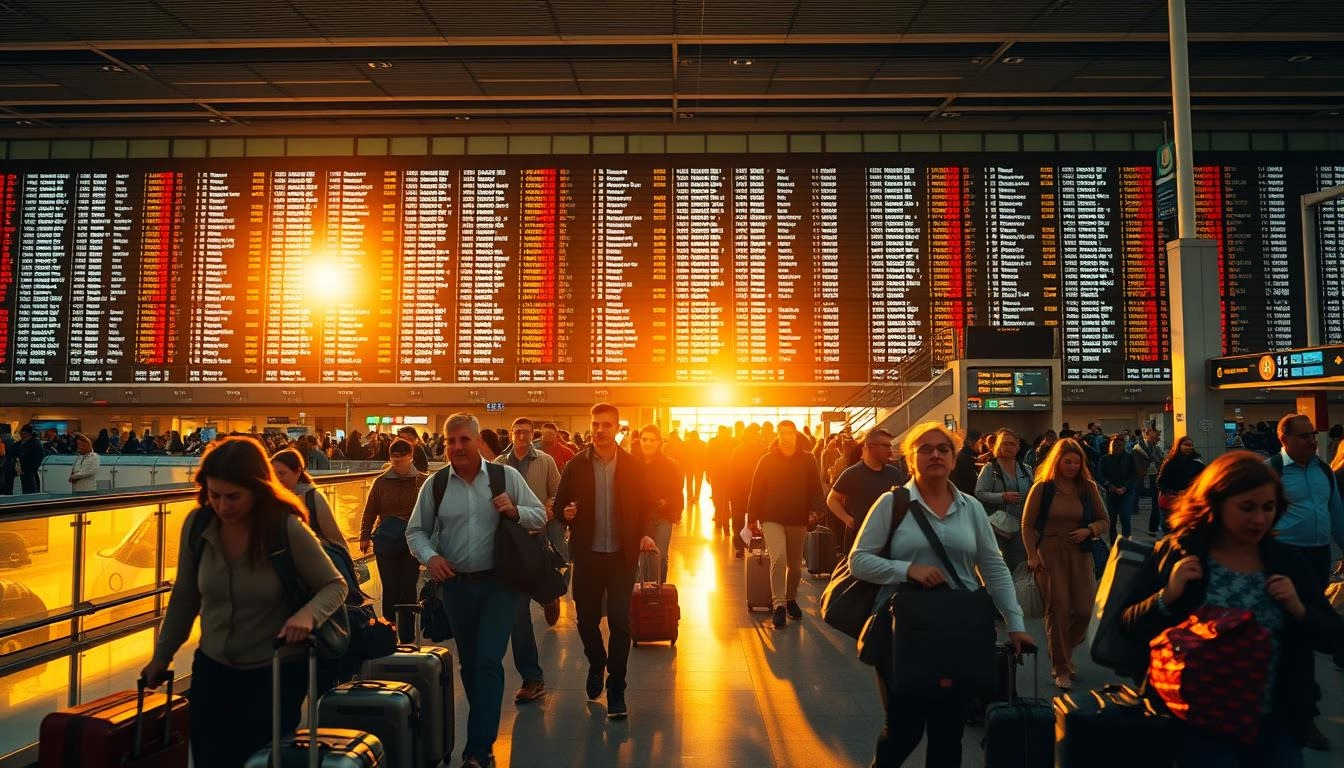The Best Time to Travel Internationally can make all the difference when it comes to scoring great deals and planning the perfect trip. While flash sales from major airlines can pop up at any time, counting on them can be unpredictable.
To make informed decisions, it’s essential to understand the relationship between booking windows, travel seasons, and flight prices. The ideal time to book international flights varies, but generally, planning three to five months is recommended.
By being flexible with your travel dates and destinations, you can significantly impact your budget and overall experience. Let’s explore how to time your international travel for maximum savings without sacrificing quality.
Understanding the Timing-Price Relationship in International Travel
When planning international travel, understanding the relationship between timing and cost is crucial. The cost of your trip can be significantly affected by when you book and when you travel.
The relationship between timing and travel cost is complex, influenced by factors such as demand, seasonality, and market trends. Airlines utilize dynamic pricing models, adjusting fares in real-time based on these factors.
Why Timing Matters for Your Budget
Timing affects not just the cost of flights, but also accommodation prices and attraction availability. Understanding this can help you make more informed decisions, potentially saving you money. By choosing the right days to travel or book, you can avoid peak demand periods.
Debunking Common Travel Timing Myths
A common myth is that there’s a single optimal day to book flights, often believed to be Tuesday. However, flight prices change constantly, adjusting to real-time demand. Another misconception is that deleting cookies or using private browsing affects flight prices, which is not the case. The reality is that the relationship between timing and price is influenced by multiple factors beyond simple calendar dates.
The Best Time to Book International Flights
The key to saving money on international flights lies in understanding when to book. According to CheapAir’s analysis, booking your international flights at the right time can lead to significant savings.
For most international destinations, the sweet spot for booking is 3-5 months in advance. This period typically offers the best balance between availability and price.
Optimal Booking Windows by Region
Different regions have different optimal booking windows. For instance:
- For travel to the Middle East and Africa, book 3-6 months in advance.
- For Europe, the optimal booking time is 5-8 months ahead.
- Asia and the South Pacific have more flexible booking windows, ranging from 1-7 months and 1-8 months, respectively.
Understanding these regional variations can help you plan more effectively.
Is Booking Last-Minute Ever a Good Idea?
While last-minute deals can sometimes be found, they are generally not recommended for international travel. According to Expedia, flights booked 2-8 months in advance average significantly less than last-minute deals.
For the best deals, it’s more effective to set price alerts rather than trying to time the market perfectly. This approach allows you to capitalize on price drops without constantly monitoring the market.
Best Days of the Week to Fly Internationally
When planning international travel, the day of the week you choose to fly can significantly impact your expenses. Research indicates that midweek flights tend to be cheaper than weekend flights.
Midweek vs. Weekend Travel: Price Differences
The price difference between midweek and weekend travel can be substantial. Generally, Tuesday and Wednesday are considered the least expensive days to fly internationally, while Sunday is often the most expensive. On average, flying on Tuesday or Wednesday can save you between $25 and $350, depending on your destination.
How Flight Timing Affects Overall Costs
Your flight day choice affects not just airfare but also related costs like airport transfers and accommodation pricing. For instance, flying on a cheaper day can sometimes lead to savings on hotel bookings if you’re traveling during the off-peak season. For international travel, Wednesdays and Saturdays are typically considered the cheapest departure days, though savings vary by destination.
Seasonal Travel Strategies to Save Money
As you plan your next international trip, understanding how seasonal changes impact travel costs can be a game-changer. The time of year you choose to travel can significantly affect your expenses, from flights and accommodations to activities and experiences.
Understanding Peak, Shoulder, and Off-Seasons
International travel is categorized into three main seasons: peak, shoulder, and off-season. Peak season typically coincides with summer months and holidays, attracting large crowds and commanding higher prices. In contrast, the shoulder season offers a balance between decent weather and moderate prices, making it an attractive option for travelers. The off-season is characterized by the lowest prices and fewest tourists, but may come with less favorable weather conditions.
Weather Considerations vs. Cost Savings
While perfect weather can enhance your travel experience, it’s essential to weigh this against potential cost savings. For instance, traveling during the shoulder season (spring or fall) can provide pleasant weather without the peak season price tag. Conversely, off-season travel to warm destinations like the Caribbean or Southeast Asia during the winter months can offer exceptional value. Ultimately, your priorities will depend on whether you value optimal weather or cost savings more.
By understanding these seasonal dynamics, you can make informed decisions that suit your budget and preferences, ensuring a more enjoyable and cost-effective international travel experience.
Regional Guide by Destination
To maximize your travel budget, it’s essential to understand the best times to visit various international destinations. Different regions have optimal travel periods based on factors like weather, local holidays, and tourism infrastructure.
Europe: Optimal Months and Seasons
Europe offers the best value from October through March, with the cheapest months including October, November, January, February, and March. The peak season, from May to July, sees prices surge, often exceeding $1,100 for flights. Booking five to eight months in advance is recommended for the best deals.
Asia and South Pacific: When to Go
For Asia travel, January and November are generally the most affordable months, while June is the most expensive. Booking one to seven months in advance is ideal. The South Pacific has unique patterns, with January, April, and May offering relative bargains despite high prices year-round.
Caribbean and Latin America: Timing Your Trip
The Caribbean and Latin America are most affordable in January, September, and October, while December commands premium prices. Booking one to eleven months in advance can secure the best deals.
Africa and the Middle East: Cost-Effective Travel Periods
For Africa and the Middle East, October, November, and February provide cost-effective travel options. A booking window of three to six months is recommended. Understanding these regional patterns can help travelers save money and enhance their experience.
By considering the weather and local events, travelers can make informed decisions about when to visit their desired destinations, ensuring a balance between cost and experience.
Holiday Travel: Finding Deals During Peak Periods
The key to affordable holiday travel lies in understanding the dynamics of peak periods and leveraging the right booking strategies. Holidays like Christmas and New Year’s are particularly challenging due to high demand.
Christmas and New Year Travel Strategies
For Christmas and New Year’s travel, booking approximately 71 days in advance is recommended, as per Google Flights’ 2023 insights. Flying on the actual holiday, like Christmas Day, can also yield significant savings compared to the days leading up to it.
Using American Holidays for International Bargains
American holidays not celebrated globally, such as Thanksgiving, can offer unique international travel opportunities with lower demand and better prices. Being flexible with travel dates, like flying the Tuesday before a Monday holiday, can also result in cheaper flights.
Leveraging airline flexible cancellation policies allows you to lock in decent rates early and rebook if prices drop. This strategy, combined with flying on less popular days, can make holiday travel more affordable.
Money-Saving Booking Strategies Beyond Timing
Smart travelers know that saving money on international travel involves more than just picking the right time to book. Several strategies can help reduce costs.
Setting Price Alerts and Using Flexible Date Tools
Utilize price alert tools from platforms like Google Flights, Hopper, Skyscanner, and Kayak to automate your deal-hunting process. These tools notify you when prices drop, allowing you to capitalize on savings. Additionally, flexible date search tools help visualize price differences across various travel dates, revealing significant savings opportunities.
Leveraging Airline Policies for Rebooking Savings
Many airlines have adopted flexible change and cancellation policies, making it easier to rebook flights and save money. To take advantage of this, ensure your original ticket doesn’t have change or cancellation fees. Then, set a price alert and rebook when prices drop. Be aware that canceling might result in a travel voucher or credit.
Points and Miles Optimization for International Travel
Optimizing points and miles can significantly reduce international travel costs. Understand the best loyalty programs for specific regions and how to maximize redemption value. Combine points from different programs to create optimal itineraries, and leverage transfer partners, credit card points, and airline alliances to access premium cabins at a fraction of the cash price.
Conclusion: Making the Most of Your International Travel Budget
As we conclude our exploration of international travel timing, it’s clear that flexibility is key to unlocking significant savings. The golden rule of cheap travel remains: be flexible with your dates, destinations, airports, and booking strategies. For most destinations, booking 3-5 months in advance is ideal, while Europe requires 5-8 months, and the Caribbean offers deals from 1-11 months ahead.
Tuesdays, Wednesdays, and Saturdays are typically the best days to fly internationally. Consider traveling during shoulder seasons (April-May and September-October) for a balance of good weather and reasonable prices. For holiday travel, booking 71 days ahead can yield significant savings. Ultimately, the best time to travel internationally depends on your destination, budget, and preferences. With proper planning and the strategies outlined in this guide, international travel can be accessible on modest budgets throughout the year.







